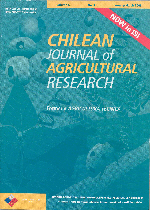
|
Agricultura Técnica
Instituto de Investigaciones Agropecuarias, INIA
ISSN: 0365-2807
EISSN: 0365-2807
Vol. 60, No. 3, 2000, pp. 216-223
|
 Bioline Code: at00019
Bioline Code: at00019
Full paper language: Spanish
Document type: Research Article
Document available free of charge
|
|
|
Agricultura Técnica, Vol. 60, No. 3, 2000, pp. 216-223
| en |
Evaluation of Chilean Strains of Metarhizium Anisopliae var. AnisopliaeAgainst Otiorhynchus SulcatusFab. (Coleoptera: Curculionidae)
Gerding, Macarena G.; France, Andrés I. & Cisternas, Ernesto A.
Abstract
The pathogenicity of three isolates of Metarhizium anisopliae var. anisopliae against the black vine weevil (Otiorhynchus sulcatus) was evaluated in a laboratory test. The isolates were applied in increasing concentrations (0 to 108 conidia mL-1) to the last instar larvae. Larval mortality was evaluated for 20 days, and lethal concentration LC50 LC90, and mortality rates were calculated. The three isolates varied (P≤ 0.01) in the rate of mortality at different concentrations. The LC50 and LC90 for the most virulent isolate were about 106 and 108 conidia mL-1, respectively. Future field studies will determine the potential of this fungus as a biological control agent for Otiorhynchus sulcatus in Chile.
Keywords
biological control, black vine weevil, entomogenous fungi, insect pathology
|
| |
| es |
Evaluación de Cepas Nativas de Metarhizium Anisopliae var. AnisopliaeSobre Otiorhynchus SulcatusFab. (Coleoptera: Curculionidae)
Gerding, Macarena G.; France, Andrés I. & Cisternas, Ernesto A.
Resumen
Se evaluó en laboratorio la patogenicidad de tres aislamientos de Metarhizium anisopliae var. anisopliae sobre el gorgojo de la frutilla (Otiorhynchus sulcatus). Los aislamientos fueron aplicados en concentraciones crecientes (0 a 108 conidias mL-1) sobre larvas en el último estadío de desarrollo. Se evaluó durante 20 días la mortalidad de larvas, calculándose la concentración letal CL50 y CL90 , y la tasa de mortalidad. La tasa de mortalidad a distintas concentraciones fue distinta para los tres aislamientos (P≤ 0,01). La CL50 y CL90 para el aislamiento más agresivo, fue de 106 y 108 respectivamente. Futuros estudios a nivel de campo permitirán determinar el potencial de este hongo como agente de control biológico de O. sulcatus en Chile.
Palabras-clave
Control biológico, gorgojo de la frutilla, hongo entomopatógeno, patología de insectos
|
| |
© Copyright 2000 - Instituto de Investigaciones Agropecuarias, INIA (Chile)
Alternative site location: http://www.inia.cl/at/agritec.htm
|
|
